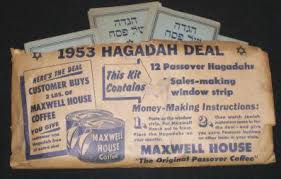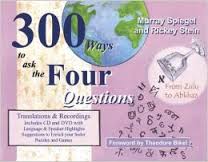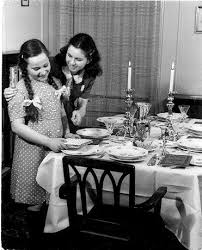How well I remember my father leading the Passover seder.
But before my father, there were the grandfathers who we were sure must have known Moses personally. The seder was long and seemed even longer as we and our cousins sat on scratchy chairs dressed in our best. The type was small and the translation archaic in the wine-stained Maxwell House Coffee edition. We were allowed 4 tiny glasses of real wine, as I remember, and we did listen to the fluent Hebrew that these men from the Old Country rattled off as if it were their mother tongue. And we really believed that Elijah came every year at the appointed time. The wine shook in the beautiful goblet, didn’t it? What further proof did we children need.
When he led, my father would carefully calculate so that the recitation of the Hagaddah-now from a more modern, colorfully illustrated haggadah-would come out the way he wanted it to. Always with a twinkle in his eyes, I, as the eldest child, was the wise child; my brother, a few years younger than I, always received the wicked child (and justly so at times, as he gave my parents far more grey hairs than did I) and the youngest of us was always the child who didn’t know what to ask.
Now I often conduct the seder and there are rarely children around the table. They have grown and moved away. But I still hear my grandfathers’ and father’s voices as we read certain lines of the text and when my brothers and I get together we share the memories.
At Passover we are enjoined to tell the story. We probably all have stories to tell about Passovers past. I wonder if the kids today are as enthralled and as believing as we were. They certainly have more knowledge but do they have that sense of wonder at the miracle of Passover-the miracle of freedom?
There have been thousands of haggadot over the centuries, over 4000 according to Amanda Seigel of the New York Public Library ( http://www.nypl.org/blog/2016/04/13/passover-resources). The haggadah is a living document reflecting time, place, ideology, art, politics and more. Be you on the right or left, a rebel or traditionalist, a carnivore or a vegetarian, gay or straight, fluent in Hebrew or totally unlettered, there is a haggadah for you. And each year brings new haggadot, some with beautiful art;others with elegant translations.
 But one of the miracles of this 2nd most celebrated Jewish ritual-though some say first most celebrated-is that every haggadah has some version of the basic requirements from hand washing to questions to story to dipping to praise.
But one of the miracles of this 2nd most celebrated Jewish ritual-though some say first most celebrated-is that every haggadah has some version of the basic requirements from hand washing to questions to story to dipping to praise.
Maybe that’s what makes us the Jewish people-we share a common infrastructure though what it looks like on the outside may be vastly different.
So no matter your custom or haggadah – Hag Sameach and a zissen-sweet-Pesach!
Below are some Passover resources from the library’s collection: (J) indicates books for younger readers.
Arrow, Creating lively Passover seders: a sourcebook of engaging tales, texts and activities
Bronfman, The Bronfman Haggadah. Tells the story of the Exodus and raises current issues.
Golden, The Passover Journey: a seder companion. (J)
Heligman, Celebrate Passover. Photo essay on customs around the world (J)
Hoffman, My People’s Passover Haggadah: traditional texts, modern commentaries.
Kanoff, The No-potato Passover: a journey of food, travel and color.
Kimmel, Wonders & Miracles: a Passover companion. Follows the seder order. (J)
Nathan, The Jewish Holiday Kitchen.
Snyder, The Longest Night: a Passover story. A child’s account of the days before the flight from Egypt. (J)
 Spiegel, 300 Ways to Ask the Four Questions: from Zulu to Abkhaz. An extraordinary survey of the world’s languages through the prism of the Haggadah.
Spiegel, 300 Ways to Ask the Four Questions: from Zulu to Abkhaz. An extraordinary survey of the world’s languages through the prism of the Haggadah.
Wayland, More Than Enough (J)
Zusman, The Passover Parrot (J)
- Is It Passover Yet? - Thu, Apr 18, 2024
- MESH Report April 9, 2024 - Thu, Apr 11, 2024
- Guess Who? - Wed, Mar 13, 2024

